Papyrus 13
|
New Testament manuscript | |
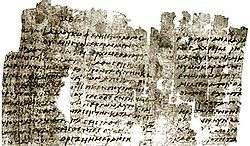 | |
| Name | P. Oxyrhynchus 657 |
|---|---|
| Text | Hebrews 2:14-5:5; 10:8-22; 10:29-11:13; 11:28-12:17 |
| Date | 225-250 |
| Script | Greek |
| Found | Oxyrhynchus, Egypt |
| Now at | British Library/Egyptian Museum |
| Cite | Grenfell & Hunt, Oxyrynchus Papyri 4:36-48. (#657) |
| Size |
12 columns of scroll; 23-27 lines/column; pagination legible: 47-50, 61-65, 67-69. |
| Type | Alexandrian, often agrees with Vaticanus; 80% with Papyrus 46 |
| Category | I |
| Note | largest papyrus other than Chester Beatty collection |
Papyrus 13, designated by siglum 13 or P13 in the Gregory-Aland numbering, is a fragmented manuscript of the New Testament in Greek. It was copied on papyrus in the 3rd century at approximately 225-250 CE.[1]
Description
Papyrus 13 was discovered by Bernard Grenfell and Arthur Hunt in Oxyrhynchus, Egypt. It is currently housed at the British Library, Inv. Nr. 1532, and Egyptian Museum, SR 3796 25/1/55/2 (11), or PSI 1292.[2][3][4]
The surviving text is twelve columns, of 23 to 27 lines each, from a scroll. This is all from the Epistle to the Hebrews, namely 2:14-5:5; 10:8-22; 10:29-11:13; 11:28-12:17. Its presence of pagination 47-50 means that Hebrews was preceded by only one book in the original scroll, likely the Epistle to the Romans as in Papyrus 46.[1] It is the largest papyrus manuscript of the New Testament outside the Chester Beatty Papyri.
It was written on the back of a papyrus containing the Epitome of Livy and some scholars think the manuscript was possibly brought to Egypt by a Roman official and left behind when he left his post.[5]
Text
Papyrus 13 is a representative of the Alexandrian text-type. Aland placed it in Category I.[2]
It bears strong textual affinity with Codex Vaticanus, and also has an 80% agreement with Papyrus 46. It has numerous distinctive readings.[2]
Papyrus 13 is written recto-verso, with the verso (back) containing Hebrews and the recto (front) containing part of Livy's History of Rome, dated to around 200 AD.[7]
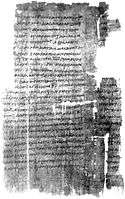
Papyrus 1532
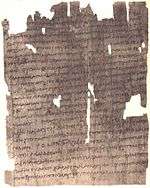
Papyrus 1532
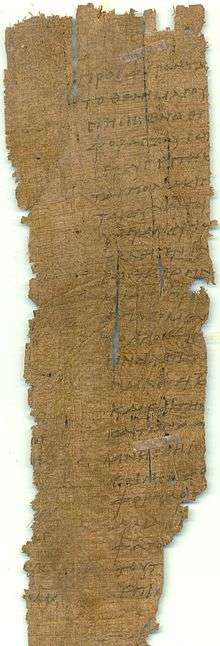
PSI 1292
See also
References
- 1 2 Philip W Comfort and David P Barrett, The Text of the Earliest New Testament Greek Manuscripts, (Wheaton, Illinois: Tyndale House Publishers Incorporated, 2001), pp 83.
- 1 2 3 Aland, Kurt; Aland, Barbara (1995). The Text of the New Testament: An Introduction to the Critical Editions and to the Theory and Practice of Modern Textual Criticism. Erroll F. Rhodes (trans.). Grand Rapids: William B. Eerdmans Publishing Company. p. 97. ISBN 978-0-8028-4098-1.
- ↑ "Handschriftenliste". Münster: Institute for New Testament Textual Research. Retrieved 23 August 2013.
- ↑ PSI XII 1292 at PSIonline
- ↑ Philip W Comfort and David P Barrett, The Text of the Earliest New Testament Greek Manuscripts, (Wheaton, Illinois: Tyndale House Publishers Incorporated, 2001), p. 85.
- ↑ C. R. Gregory, Textkritik des Neuen Testaments III (Leipzig: 1909), p. 1091.
- ↑ Comfort, Philip W.; David P. Barrett (2001). The Text of the Earliest New Testament Greek Manuscripts. Wheaton, Illinois: Tyndale House Publishers. pp. 83–92. ISBN 978-0-8423-5265-9.
Further reading
- B. P., Grenfell; Hunt, A. S. (1904). Oxyrhynchus Papyri IV. London. pp. 36–48.
- Vittorio Bartoletti and M. Norsi, Papiri greci e latini della Società Italiana, vol. 12 (1951), p. 209-210 (PSI 1292).
- Gregory, Caspar René (1908). Die griechischen Handschriften des Neuen Testament. Leipzig: J.C. Hinrichs’sche Buchhandlung. p. 47.
External links
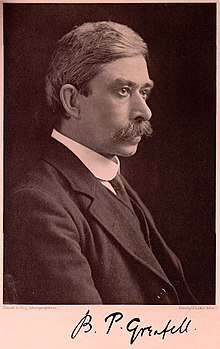 |
 | |
- Aland, K and Aland, B (1995), The Text of the New Testament, p. 97, Trans. Rhodes, EF, Pub. Wm. B. Eerdmans. ISBN 0-8028-4098-1
- Robert B. Waltz. 'NT Manuscripts: Papyri, Papyri P13.' Image of P13